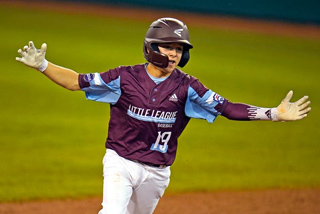 Pitchers at all levels are stronger and throw harder than ever, increasing the risk for batters. On May 17, Jacob Webb of the Braves hit the Mets Kevin Pillar in the face with a 94-mph fastball, causing multiple fractures. Following successful surgery Pillar returned to the lineup, with one significant change. His helmet now has a C-flap. Pitchers at all levels are stronger and throw harder than ever, increasing the risk for batters. On May 17, Jacob Webb of the Braves hit the Mets Kevin Pillar in the face with a 94-mph fastball, causing multiple fractures. Following successful surgery Pillar returned to the lineup, with one significant change. His helmet now has a C-flap.
At the World Series this year, Little League's failure to require all batters—none of whom is older than 12—to have the side of their faces protected is frightening. It's also completely unnecessary.
In Monday's Little League game between Texas and Michigan, for example, Cason Parrish of the Texas team was hit high on his shoulder, just inches from his jaw. Though some players wore C-flap helmets that day, Parrish did not. How is that possible?
The Little League organization, which began in Pennsylvania in 1939 and added the World Series tournament in 1947, has always expressed interest in player safety. Back in the 1950s, when I played Little League ball, helmets hadn't been perfected but we wore a crude type of head protection that was like a set of hard plastic earmuffs, held to the side of the head with elastic bands.
On the Big League level, a few players experimented with protective headgear as early as 1905. In 1940, the president of the National League, Ford Frick, designed a helmet, worn in a game that year by Jackie Hayes of the White Sox. Frick said in an interview: "[A batting helmet] is the only way I know that we can prevent head injuries and the only way we can make the players wear them is make it a league rule." Yet, Frick's own league didn't create such a rule for another 16 years, and Major League Baseball waited until 1971 to issue a comprehensive helmet mandate.
In the 1970s a plastic surgeon named Robert Crow invented the C-flap, named for the area it protected, the cheek, as well as for "Crow." Hardly any players used it, except those recovering from having been hit in the face. But in 2018, several big stars, including Bryce Harper and Mike Trout, began wearing C-flaps and almost immediately other players joined in.
How Little League got left behind in this critical area of player safety is a tale of legal mumbo jumbo. When USA Today looked into the matter in 2018, it found: "The National Operating Committee on Standards for Athletic Equipment says add-ons to athletic helmets potentially void manufacturer safety certifications. Amateur baseball governing bodies by and large abide by NOCSAE standards."
The problem was that C-flaps were affixed to helmets with screws; they didn't come from the manufacturers already attached. Fearing lawsuits, Little League basically outlawed a form of player safety that it should have been mandating.
As unfortunate as that was three years ago, it is has little relevance today. Most suppliers of baseball helmets now make models with C-flaps built in. That's why players at the Little League World Series are allowed to use them—but many don't.
Although claiming on its website that, "The safety of all our participants is our utmost concern," Little League continues to flog NOCSAE requirements about "add-ons," when what it should be doing is requiring all players to wear helmets manufactured with full cheek protection.
Sadly, it often takes a horrible accident for things to change. Major League coaches at first and third base never wore helmets until 2007 when minor-league coach Mike Coolbaugh was struck in the head by a batted ball and died. The following year MLB mandated that all coaches wear helmets when on the field.
It's too late for Little League to change its ways this year, so let's hope no young player gets hurt. Next season, make C-flaps mandatory. When it comes to safety, Little League should be pro active.
(c) Peter Funt. This column originally appeared in USA Today.
|



 Pitchers at all levels are stronger and throw harder than ever, increasing the risk for batters. On May 17, Jacob Webb of the Braves hit the Mets Kevin Pillar in the face with a 94-mph fastball, causing multiple fractures. Following successful surgery Pillar returned to the lineup, with one significant change. His helmet now has a C-flap.
Pitchers at all levels are stronger and throw harder than ever, increasing the risk for batters. On May 17, Jacob Webb of the Braves hit the Mets Kevin Pillar in the face with a 94-mph fastball, causing multiple fractures. Following successful surgery Pillar returned to the lineup, with one significant change. His helmet now has a C-flap.